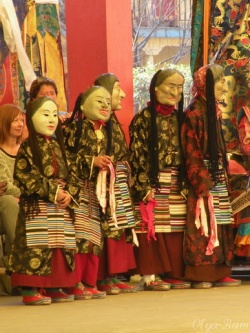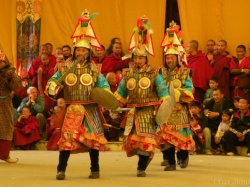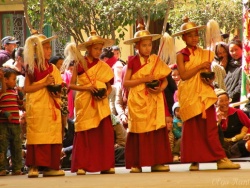Difference between revisions of "Cham dance"
(Created page with "thumb|250px| The cham dance (Tibetan: འཆམ་, Wylie: cham; Chinese: 跳欠; pinyin: tiàoqiàn), also spelled tscham or chaam, is ...") |
|||
| Line 1: | Line 1: | ||
[[File:DSCN9794.JPG|thumb|250px|]] | [[File:DSCN9794.JPG|thumb|250px|]] | ||
| − | The [[cham]] dance (Tibetan: | + | The [[cham]] dance ([[Tibetan]]: {{BigTibetan|[[འཆམ]]་}}, Wylie: [[cham]]; {{Wiki|Chinese}}: 跳欠; pinyin: [[tiàoqiàn]]), also spelled [[tscham]] or [[chaam]], is a lively masked and costumed dance associated with some sects of [[Buddhism]], and is part of [[Buddhist festivals]]. The dance is accompanied by {{Wiki|music}} played by [[monks]] using [[traditional]] [[Tibetan]] instruments. The dances often offer [[moral]] instruction relating to [[compassion]] for [[sentient beings]] and are held to bring [[merit]] to all who {{Wiki|perceive}} them. |
[[File:DSCN9785.JPG|thumb|250px|]] | [[File:DSCN9785.JPG|thumb|250px|]] | ||
| − | [[Cham dances]] are considered a form of meditation, and an offering to the gods. The leader of the [[cham]] is typically a musician, keeping time using some percussion instrument like cymbals, the one exception being [[Dramyin Cham]] - where time is kept using [[dramyin]]. | + | [[Cham dances]] are considered a [[form]] of [[meditation]], and an [[offering]] to the [[gods]]. The leader of the [[cham]] is typically a musician, keeping [[time]] using some percussion instrument like [[cymbals]], the one exception being [[Dramyin Cham]] - where [[time]] is kept using [[dramyin]]. |
[[File:DSCN9776.JPG|thumb|250px|]] | [[File:DSCN9776.JPG|thumb|250px|]] | ||
[[Cham]] content | [[Cham]] content | ||
| − | [[Chams]] often depict incidents from the life of [[Padmasambhava]], the 9th century [[Nyingmapa]] teacher and other saints. | + | [[Chams]] often depict incidents from the [[life]] of [[Padmasambhava]], the 9th century [[Nyingmapa]] [[teacher]] and other {{Wiki|saints}}. |
| − | The great debate of the Council of Lhasa between the two principal debators or dialecticians, [[Mo Ho Yen]] and [[Kamalaśīla]] is narrated and depicted in a specific [[cham]] dance once held annually at [[Kum-Bum Dshamba Ling]], Tibet. | + | The great [[debate]] of the [[Council of Lhasa]] between the two principal debators or dialecticians, [[Mo Ho Yen]] and [[Kamalaśīla]] is narrated and depicted in a specific [[cham]] dance once held annually at [[Kum-Bum Dshamba Ling]], [[Tibet]]. |
Localities | Localities | ||
| Line 14: | Line 14: | ||
{{Wiki|Bhutan}} | {{Wiki|Bhutan}} | ||
| − | In Bhutan, the dances are performed during an annual religious festival known as [[Tsechu]], which is held in each district. Only monks or male members of the Royal Academy of Performing Arts are allowed to perform a [[cham]] dance in Bhutan. | + | In [[Bhutan]], the dances are performed during an annual [[religious]] {{Wiki|festival}} known as [[Tsechu]], which is held in each district. Only [[monks]] or {{Wiki|male}} members of the {{Wiki|Royal}} {{Wiki|Academy}} of Performing Arts are allowed to perform a [[cham]] dance in [[Bhutan]]. |
| − | China | + | [[China]] |
| − | Tibetans in China usually perform the [[cham]] dance to large audiences during the Monlam Prayer Festival. | + | [[Tibetans]] in [[China]] usually perform the [[cham]] dance to large audiences during the [[Monlam Prayer Festival]]. |
| − | India | + | [[India]] |
| − | Dances are performed in Sikkim, Dharamsala and Ladakh during cultural and religious festivals. | + | Dances are performed in [[Sikkim]], {{Wiki|Dharamsala}} and {{Wiki|Ladakh}} during {{Wiki|cultural}} and [[religious]] festivals. |
{{W}} | {{W}} | ||
---------------------------------------------------------------------------------- | ---------------------------------------------------------------------------------- | ||
| − | The Lamas take to | + | The [[Lamas]] take to ‘[[dancing]]’ (chaam) three to four times a year. Four, if they are in [[Sikkim]]; ‘[[dancing]]’ during [[Phang Lhabsol]] in addition to [[Kagyed]], [[Losoong]] and [[Bumchu]], all of which falls at the end of the harvest season in December-January annually. |
| − | Mask dances are part of religious and cultural traditions and the holy scripts, which dates back to the 8th century AD. The Tibetan Lamas practice the religious [[chaam]] with great fervor and although the [[chaams]] may take on different forms, they generally commemorates the [[Padmasambhava]]. | + | Mask dances are part of [[religious]] and {{Wiki|cultural}} [[traditions]] and the {{Wiki|holy}} scripts, which dates back to the 8th century AD. The [[Tibetan]] [[Lamas]] practice the [[religious]] [[chaam]] with great fervor and although the [[chaams]] may take on different [[forms]], they generally commemorates the [[Padmasambhava]]. |
| − | In a layperson’s context, the mask dance usually consists of two parts: the first honors and pays homage to the eight aspects of [[Padmasambhava]]. And the second part of the performance shows [[Maha Dongcren]], a horned masked figure, slaying the demonic force. | + | In a layperson’s context, the mask dance usually consists of two parts: the first honors and pays homage to the eight aspects of [[Padmasambhava]]. And the second part of the performance shows [[Maha Dongcren]], a horned masked figure, slaying the {{Wiki|demonic}} force. |
| − | These chaams are usually performed in the courtyard of monasteries by the Buddhist Lamas that resides in the monasteries. The main theme of the dance deals with propitiating the deity, killing the evil king and protecting the people from the wrath of natural calamities, diseases and epidemics and ensuring health, happiness and prosperity for the people of the area. | + | These chaams are usually performed in the courtyard of [[monasteries]] by the [[Buddhist]] [[Lamas]] that resides in the [[monasteries]]. The main theme of the dance deals with propitiating the [[deity]], killing the [[evil]] [[king]] and protecting the [[people]] from the [[wrath]] of natural {{Wiki|calamities}}, {{Wiki|diseases}} and epidemics and ensuring health, [[happiness]] and {{Wiki|prosperity}} for the [[people]] of the area. |
| − | The [[chaam]] dance steps are generally slow, with the exception of leaps and performed in a circular movement (both clockwise and anti-clockwise) with big, colorful masks and grotesque expressions. The [[chaam]] is performed in accompaniment with the beats of drums, cymbals and long pipes, all of which are played by the Lamas. | + | The [[chaam]] dance steps are generally slow, with the exception of leaps and performed in a circular {{Wiki|movement}} (both {{Wiki|clockwise}} and anti-clockwise) with big, colorful masks and grotesque expressions. The [[chaam]] is performed in accompaniment with the beats of drums, [[cymbals]] and long pipes, all of which are played by the [[Lamas]]. |
| − | The Lamas also prepare the masks themselves, which is typically made of wood and papier-mâché with a thin coat of plaster. The masks usually portrayed are of [[Yama]] (the [[Lord of Death]]) and his demons, Padmasambhava (the [[second Buddha]]), the God of Wealth, and the protector of horses and other animals, all of which has a significance of its own and is featured at different intervals of the [[chaam]] performance that can last up to 10 hours long. Masks are generally not tailored made to the size of the dancing Lama, but bigger, to cater for Lamas of different ages and sizes. | + | The [[Lamas]] also prepare the masks themselves, which is typically made of wood and papier-mâché with a thin coat of plaster. The masks usually portrayed are of [[Yama]] (the [[Lord of Death]]) and his {{Wiki|demons}}, [[Padmasambhava]] (the [[second Buddha]]), the [[God of Wealth]], and the [[protector]] of horses and other [[animals]], all of which has a significance of its own and is featured at different intervals of the [[chaam]] performance that can last up to 10 hours long. Masks are generally not tailored made to the size of the [[dancing]] [[Lama]], but bigger, to cater for [[Lamas]] of different ages and sizes. |
| − | Despite being performed by Lamas of all ages and sizes that adorns heavy layers of robes and the gaily painted masks that is heavy and uncomfortable, in addition to clumsy ceremonial swords and bells, the performance my the dancing Lamas is well choreographed and demonstrates grace and perfect footwork. | + | Despite being performed by [[Lamas]] of all ages and sizes that adorns heavy layers of [[robes]] and the gaily painted masks that is heavy and uncomfortable, in addition to clumsy {{Wiki|ceremonial}} swords and [[bells]], the performance my the [[dancing]] [[Lamas]] is well choreographed and demonstrates grace and perfect footwork. |
{{R}} | {{R}} | ||
[http://travelgspots.wordpress.com/2013/05/13/my-travel-diary-chasing-dancing-lamas/ travelgspots.wordpress.com/] | [http://travelgspots.wordpress.com/2013/05/13/my-travel-diary-chasing-dancing-lamas/ travelgspots.wordpress.com/] | ||
[[Category:Lama Dancing]] | [[Category:Lama Dancing]] | ||
Revision as of 09:27, 11 October 2013
The cham dance (Tibetan: འཆམ་, Wylie: cham; Chinese: 跳欠; pinyin: tiàoqiàn), also spelled tscham or chaam, is a lively masked and costumed dance associated with some sects of Buddhism, and is part of Buddhist festivals. The dance is accompanied by music played by monks using traditional Tibetan instruments. The dances often offer moral instruction relating to compassion for sentient beings and are held to bring merit to all who perceive them.
Cham dances are considered a form of meditation, and an offering to the gods. The leader of the cham is typically a musician, keeping time using some percussion instrument like cymbals, the one exception being Dramyin Cham - where time is kept using dramyin.
Cham content
Chams often depict incidents from the life of Padmasambhava, the 9th century Nyingmapa teacher and other saints.
The great debate of the Council of Lhasa between the two principal debators or dialecticians, Mo Ho Yen and Kamalaśīla is narrated and depicted in a specific cham dance once held annually at Kum-Bum Dshamba Ling, Tibet.
Localities
In Bhutan, the dances are performed during an annual religious festival known as Tsechu, which is held in each district. Only monks or male members of the Royal Academy of Performing Arts are allowed to perform a cham dance in Bhutan.
Tibetans in China usually perform the cham dance to large audiences during the Monlam Prayer Festival.
Dances are performed in Sikkim, Dharamsala and Ladakh during cultural and religious festivals.
Source
The Lamas take to ‘dancing’ (chaam) three to four times a year. Four, if they are in Sikkim; ‘dancing’ during Phang Lhabsol in addition to Kagyed, Losoong and Bumchu, all of which falls at the end of the harvest season in December-January annually.
Mask dances are part of religious and cultural traditions and the holy scripts, which dates back to the 8th century AD. The Tibetan Lamas practice the religious chaam with great fervor and although the chaams may take on different forms, they generally commemorates the Padmasambhava.
In a layperson’s context, the mask dance usually consists of two parts: the first honors and pays homage to the eight aspects of Padmasambhava. And the second part of the performance shows Maha Dongcren, a horned masked figure, slaying the demonic force.
These chaams are usually performed in the courtyard of monasteries by the Buddhist Lamas that resides in the monasteries. The main theme of the dance deals with propitiating the deity, killing the evil king and protecting the people from the wrath of natural calamities, diseases and epidemics and ensuring health, happiness and prosperity for the people of the area.
The chaam dance steps are generally slow, with the exception of leaps and performed in a circular movement (both clockwise and anti-clockwise) with big, colorful masks and grotesque expressions. The chaam is performed in accompaniment with the beats of drums, cymbals and long pipes, all of which are played by the Lamas.
The Lamas also prepare the masks themselves, which is typically made of wood and papier-mâché with a thin coat of plaster. The masks usually portrayed are of Yama (the Lord of Death) and his demons, Padmasambhava (the second Buddha), the God of Wealth, and the protector of horses and other animals, all of which has a significance of its own and is featured at different intervals of the chaam performance that can last up to 10 hours long. Masks are generally not tailored made to the size of the dancing Lama, but bigger, to cater for Lamas of different ages and sizes.
Despite being performed by Lamas of all ages and sizes that adorns heavy layers of robes and the gaily painted masks that is heavy and uncomfortable, in addition to clumsy ceremonial swords and bells, the performance my the dancing Lamas is well choreographed and demonstrates grace and perfect footwork.


